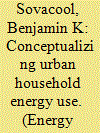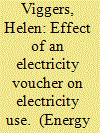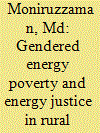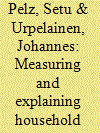|
|
|
Sort Order |
|
|
|
Items / Page
|
|
|
|
|
|
|
| Srl | Item |
| 1 |
ID:
137697


|
|
|
|
|
| Summary/Abstract |
The CA-TIMES optimization model of the California Energy System (v1.5) is used to understand how California can meet the 2050 targets for greenhouse gas (GHG) emissions (80% below 1990 levels). This model represents energy supply and demand sectors in California and simulates the technology and resource requirements needed to meet projected energy service demands. The model includes assumptions on policy constraints, as well as technology and resource costs and availability. Multiple scenarios are developed to analyze the changes and investments in low-carbon electricity generation, alternative fuels and advanced vehicles in transportation, resource utilization, and efficiency improvements across many sectors. Results show that major energy transformations are needed but that achieving the 80% reduction goal for California is possible at reasonable average carbon reduction cost ($9 to $124/tonne CO2e at 4% discount rate) relative to a baseline scenario. Availability of low-carbon resources such as nuclear power, carbon capture and sequestration (CCS), biofuels, wind and solar generation, and demand reduction all serve to lower the mitigation costs, but CCS is a key technology for achieving the lowest mitigation costs.
|
|
|
|
|
|
|
|
|
|
|
|
|
|
|
|
| 2 |
ID:
150914


|
|
|
|
|
| Summary/Abstract |
In this article we conceptualise energy use from a capabilities perspective, informed by the work of Amartya Sen, Martha Nussbaum and others following them. Building on this, we suggest a corresponding definition of energy poverty, as understood in the capabilities space. We argue that such an understanding provides a theoretically coherent means of comprehending the relationship between energy and wellbeing, and thus conceptualising energy deprivation, that makes sense across settings including both the global North and South: a coherence which has previously been lacking. At the same time, it has the flexibility to be deployed in a way that is sensitive to local contexts. Understanding energy use in the capabilities space also provides a means for identifying multiple sites of intervention, including some areas that are currently largely overlooked. We argue that this is advantageous for attempts to address energy poverty in the context of climate change and imperatives for the containment of aggregate energy consumption.
|
|
|
|
|
|
|
|
|
|
|
|
|
|
|
|
| 3 |
ID:
103465


|
|
|
|
|
| Publication |
2011.
|
| Summary/Abstract |
This article begins by defining energy services and identifying how they differ according to sector, urban and rural areas, and direct and indirect uses. It then investigates household energy services divided into three classes: lower income, middle income, and upper income. It finds that the primary energy technologies involved with low-income households involve a greater number of fuels and carriers, ranging from dung and fuelwood to liquefied petroleum gas and charcoal, but a fewer number of services. Middle-income households throughout the world tend to rely on electricity and natural gas, followed by coal, liquefied petroleum gas, and kerosene. These homes utilize energy to produce a much broader range services. The upper class or rich have access to the same energy fuels, carriers, and technologies as middle-income homes and families, but consume more energy (and more high luxury items). The study highlights how focusing on energy services reorients the direction of energy policy interventions, that energy services are neither uniform nor innate, and by noting exciting areas of potential research.
|
|
|
|
|
|
|
|
|
|
|
|
|
|
|
|
| 4 |
ID:
169733


|
|
|
|
|
| Summary/Abstract |
The aim of this paper is to examine the effect of receiving a voucher for electricity on the electricity use of a household. The Warm Homes for Elder New Zealanders Study was a randomised controlled trial which gave participants aged over 55 with chronic obstructive pulmonary disease a voucher providing NZ$500 credit to their electricity account for one winter. Electricity use increased over the winter the participant received the voucher. Participants with lower initial electricity use increased their consumption by about 10%, those with medium- or high-initial use by 2–3%. However, most participants did not use the entire value of the voucher on additional electricity. The study involved only a small informational component: this consisted of a brochure sent to the participants to encourage them to increase their energy use. This was designed to mimic the effects of a possible widespread rollout of this programme. The policy implication of this analysis is that a winter energy voucher accompanied by minimal education was effective at increasing winter energy use among a vulnerable sub-population with a health condition that merited additional heating in winter.
|
|
|
|
|
|
|
|
|
|
|
|
|
|
|
|
| 5 |
ID:
113437


|
|
|
|
|
| Publication |
2012.
|
| Summary/Abstract |
The investigation is an attempt to apply a set of consistent and official definitions of energy services (ES), energy efficiency services (EES) and energy performance contracting (EPC) on a well-developed market: France. After defining the historical context of the French market the authors describe the types of offers that are presently made and that fall within the definition of energy services. There are many classic and novel factors for the success of energy services. For instance, the energy services market is now partly structured by the CEE scheme, the French 'white certificates' or 'energy certificates scheme'. Also the grid problems lead to new services. The companies active on the market are described as a result of an empirical survey of ES market in France. This empirical survey of ES market in France includes estimates of the number of companies and of their turnover both for ES and EES. Examples and case studies are developed as a background.
|
|
|
|
|
|
|
|
|
|
|
|
|
|
|
|
| 6 |
ID:
191291


|
|
|
|
|
| Summary/Abstract |
It is widely acknowledged that the servitisation of energy retail has the potential to reduce costs and environmental impact. However, there persists a limited awareness of what market activities the energy service concept can translate into, especially in Smart Local Energy Systems (SLES). In this paper an analytical framework is developed, tested, and applied to help clarify the energy service concept, assess where its application is most appropriate in such systems, and facilitate a more strategic approach to value creation at both household and systems level to support the transition to net zero. First, we develop it through a content analysis of the energy service field's most cited papers. Second, we test its boundaries at household level through a round of interviews. Third, we demonstrate its relevance at the energy systems level by applying it in two SLES contexts. Its application revealed that focusing on value creation through material-centric energy services alone is unviable while their coordinated integration into SLES involving centralised data-centric activities creates a potential business case around network reinforcement savings and flexibility provision. For the energy service concept to succeed in the residential sector, contractual service offerings require place-based energy system integration to align with network characteristics.
|
|
|
|
|
|
|
|
|
|
|
|
|
|
|
|
| 7 |
ID:
166476


|
|
|
|
|
| Summary/Abstract |
Distributed energy resource technologies (DERs) allow consumers to generate, trade, reduce, and shift their electricity consumption, largely bypassing traditional utilities. DERs can reduce consumer reliance on the grid, and in the most extreme scenario self-sufficient consumers could disconnect from the grid and avoid all external charges. However, since most DERs delivers energy, but not reliable capacity, it would be in the interests of most of these consumers to stay connected to the networks, in the event their system fails. Such a ‘pay as you go’ price scheme would not reflect the opportunity cost of electricity firms' sudden idle infrastructure though
|
|
|
|
|
|
|
|
|
|
|
|
|
|
|
|
| 8 |
ID:
176865


|
|
|
|
|
| Summary/Abstract |
This paper investigates the relationship between gender and energy poverty as a matter of energy (in)justice. Energy poverty is generally conceived of and measured at the household level, obscuring potential gender differences in the costs and benefits of energy and fuel usage and in access to energy services. Drawing on qualitative work with women, men and community leaders in a case study in rural Bangladesh, we show that men and women's energy poverty is different when assessed in terms of a multi-dimensional, service-based definition of energy poverty, and argue that along with the differential impacts of the use of traditional fuels, this constitutes gender-based distributional energy injustice. We further investigate how this injustice is connected to a lack of procedural energy justice and a lack of recognition for women, especially those living in rural poverty, at different scales of governance, from the household to national energy policy. We argue that an energy justice lens is valuable in analysing the gender-energy nexus to reveal its social dynamics, and in pointing to policy directions to ameliorate women's energy poverty that are beyond the solely technical.
|
|
|
|
|
|
|
|
|
|
|
|
|
|
|
|
| 9 |
ID:
174989


|
|
|
|
|
| Summary/Abstract |
Household electrification aims to provide populations with access to a wide range of energy services for social and economic development, ranging from lighting to electric cooking. Electrification policy has historically focused on grid connections, however, rather than household capabilities to satisfy energy service needs. We explore a representative panel dataset of households from rural areas of six states across northern India in order to link distinct dimensions of electricity supply with electrical energy service utilisation. Using a regression framework, we show that household electrification policy in India must look beyond connections and consider disaggregate dimensions of supply, paying special attention to supply availability measured in hours per day. Following electrification, households surveyed were highly likely to utilise lighting and ICTs regardless of availability, while an improvement of 12 h was associated with higher likelihoods of space cooling (12.3%-points [CI: 10.7 to 13.9]) and entertainment (13.4%-points [11.2 to 15.6]) services utilisation. In contrast, mechanical loads, thermal loads, refrigeration and electric cooking remain constrained by household wealth and other factors. Disaggregate supply analysis supports the shift towards electrification policy that unlocks desired capabilities while using all available technologies, both grid and off-grid, to achieve more just outcomes for all.
|
|
|
|
|
|
|
|
|
|
|
|
|
|
|
|
| 10 |
ID:
175032


|
|
|
|
|
| Summary/Abstract |
Energy poverty has evolved as an important issue of research from academic and policy perspectives during the last two decades. The energy poverty estimates exhibit widespread variations across regions, methodologies and datasets, making the task of energy and development policies challenging. The variations in energy poverty estimates necessitate a systematic and rigorous analysis of these empirical studies to obtain a true measure of energy poverty. The present study conducts a meta-analysis of 30 studies and 103 estimates of energy poverty. On average, 71.1 percent of the population in the overall sample studies has been identified as energy poor. High I-square statistic values suggest heterogeneity bias in the sample studies; therefore, analysis at the subgroup level has been conducted. Meta-regression analysis of overall sample and subgroups has identified type of methodology, citations, impact factor of the journal, regional dummies, average key crude oil price and gross domestic product as significant factors that explain heterogeneity in the energy poverty effect sizes. We recommend inclusion of local and regional factors in assessment of energy poverty for developing a uniform methodology to assess energy poverty across developing economies.
|
|
|
|
|
|
|
|
|
|
|
|
|
|
|
|
| 11 |
ID:
113496


|
|
|
|
|
| Publication |
2012.
|
| Summary/Abstract |
Access to energy services has been recognised as central to achieving economic growth and sustainable development. However, almost 1.3 billion people in the world still lack access to electricity and 2.7 billion lack access to clean cooking facilities. In this backdrop, the issue of energy access is receiving more interest than ever before and this has brought to the fore, the need for a robust decision support tool for policy makers to measure the progress of energy access provision and also to provide direction for future policy making. The paper studies existing definitions of energy access and identifies the key requirements for an appropriate decision-making tool to measure and monitor energy access provision. In this context the paper assesses the strengths and weaknesses of the metrics currently being used to measure energy access in policy, as well as of contemporary monitoring and evaluation frameworks being used in other sectors. Based on these insights, a dashboard of indicators is proposed as an alternate decision support tool for policy makers to measure energy access. The paper concludes with a discussion on what is needed to operationalise this proposed framework.
|
|
|
|
|
|
|
|
|
|
|
|
|
|
|
|
| 12 |
ID:
092783


|
|
|
|
|
| Publication |
2009.
|
| Summary/Abstract |
Provision of modern energy services for cooking (with gaseous fuels) and lighting (with electricity) is an essential component of any policy aiming to address health, education or welfare issues; yet it gets little attention from policy-makers. Secure, adequate, low-cost energy of quality and convenience is core to the delivery of these services. The present study analyses the energy consumption pattern of Indian domestic sector and examines the urban-rural divide and income energy linkage. A comprehensive analysis is done to estimate the cost for providing modern energy services to everyone by 2030. A public-private partnership-driven business model, with entrepreneurship at the core, is developed with institutional, financing and pricing mechanisms for diffusion of energy services. This approach, termed as EMPOWERS (entrepreneurship model for provision of wholesome energy-related basic services), if adopted, can facilitate large-scale dissemination of energy-efficient and renewable technologies like small-scale biogas/biofuel plants, and distributed power generation technologies to provide clean, safe, reliable and sustainable energy to rural households and urban poor. It is expected to integrate the processes of market transformation and entrepreneurship development involving government, NGOs, financial institutions and community groups as stakeholders.
|
|
|
|
|
|
|
|
|
|
|
|
|
|
|
|
|
|
|
|
|